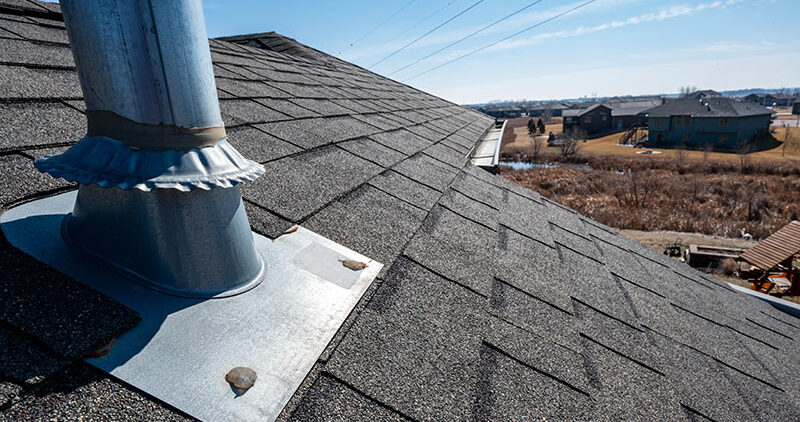Should I Replace Roof Flashing During A Roof Replacement?
Buying a new roof is an emotionally draining and expensive project. But if you want your home and family to be protected, sometimes you have to take the plunge and invest in a new roof.
That doesn’t mean all your roof components must be replaced at once. You might be able to wait on things like gutters, soffit, and fascia to save money.
It’s hard to know what parts of the roof you need to invest in replacing and what parts of the roof can stay. And when you can’t decide on the must-haves, how can you budget?
Rescue My Roof has helped homeowners solve this puzzle for over a decade, walking them through each step of the process to ensure their roof is the best on the block.
This article will examine whether roof flashing is necessary to replace. In the end, you’ll be able to tell if it’s something you should incorporate into your budget.
Do You Have to Replace Your Roof Flashing During A Roof Replacement?

Will you have to replace your roof flashing when getting a new roof? Unfortunately, there is no definite answer for every roof.
Ultimately, it comes down to the condition of your current flashing. If your flashing is rusted, has holes, or has separated from your roof, it will need to be replaced. A roofing contractor will examine the flashing to determine if it still has integrity.
If your flashing is still in good condition, you may reuse it to save money.
If the flashing is in bad condition, it must be replaced to avoid leaks and costly repairs.
Regardless of how good your flashing is, we recommend replacing it simultaneously with your roof. Traditionally, with correct installation, the flashing only lasts the roof’s life. Even if it’s in good shape now, it may only have a few more years.
When it comes to repairs, a repairperson will have to remove everything above the flashing, resulting in higher costs. In the long run, having your flashing replaced during a roof replacement will save time and money.
3 Factors to Consider When Potentially Replacing Roof Flashing
Flashing can be salvaged if it doesn’t have holes or rust. However, it is always recommended to replace metal flashing at the same time as your roof, so the old flashing doesn’t impact the integrity of your roof.
Here are three factors your roofing contractor will consider when determining whether or not the flashing needs to be replaced:
1. Flashing Condition
Your roofing contractor will inspect the flashing and determine whether its anticipated lifespan corresponds with your roof’s lifespan. Flashings like drip edges and those around your vents may be reused if they are in “like new” condition.
“Like new” condition means they do not show excessive wear or damage. For example, they won’t have corrosion, rust, tearing, or any physical damage from the roof tear-off.
If your flashing is still in “like new” condition, there are still two other factors to consider: shingle size and flashing material.
2. Shingle Size
Not all flashing is made equal. There are different sizes of flashing that need to be used based on the shingle you have chosen.
You will need to pay attention to the plumbing vent size and step flashing. Plumbing vent flashing needs to be just wider than the diameter of your vent. If it is the same size as the vent or smaller, it will be ineffective and may result in leaks.
Step flashing is a metal piece bent at a 90-degree angle in areas where your roof meets a wall. Your step flashing pieces need to be ten inches (254 mm) long and at least two inches (50 mm) wider than the exposure of the shingle you’re using.
To ensure the integrity of your roof, pay attention to flashing sizes and how they correspond to shingle size.
3. Flashing Material
When it comes to flashing materials, paying attention to both your current and new flashing materials is essential.
Some homes may have older plastic flashing that is no longer recommended in the roofing industry. If this is the case, your flashing will have to be replaced regardless of if it’s deteriorating.
Building codes in your area may determine which flashing materials you can use. Most building codes require 26-gauge galvanized steel as a minimum. However, they may also recommend non-corroding metals like aluminum and copper.
Replacing Your Roof Flashing
If you’re planning a roof replacement or experiencing leaks, it may be time to check out replacing your flashing.
While it’s not always required, it’s recommended that flashing be replaced simultaneously with a roof to avoid future repairs and have corresponding lifespans between your roof and flashing.
Are you debating on whether or not it’s time to get your roof inspected? Read “5 Signs It’s Time For An Asphalt Roof Replacement,” or download our Buyer’s Guide to learn more.
If you’re ready to get started with a roof inspection, you can become one of the hundreds of happy homeowners working with Rescue My Roof. Contact us today to schedule a free, fast, and honest roof estimate and determine if you need a roof or flashing replacement.


